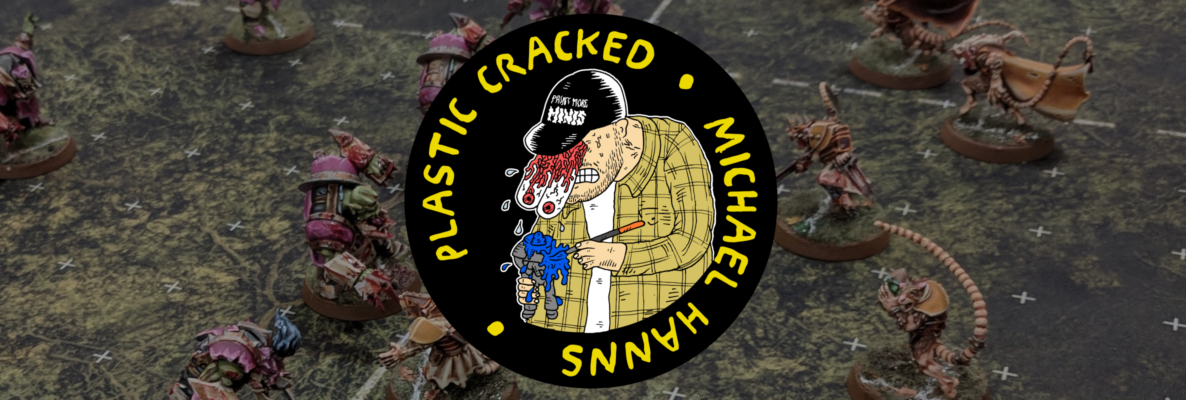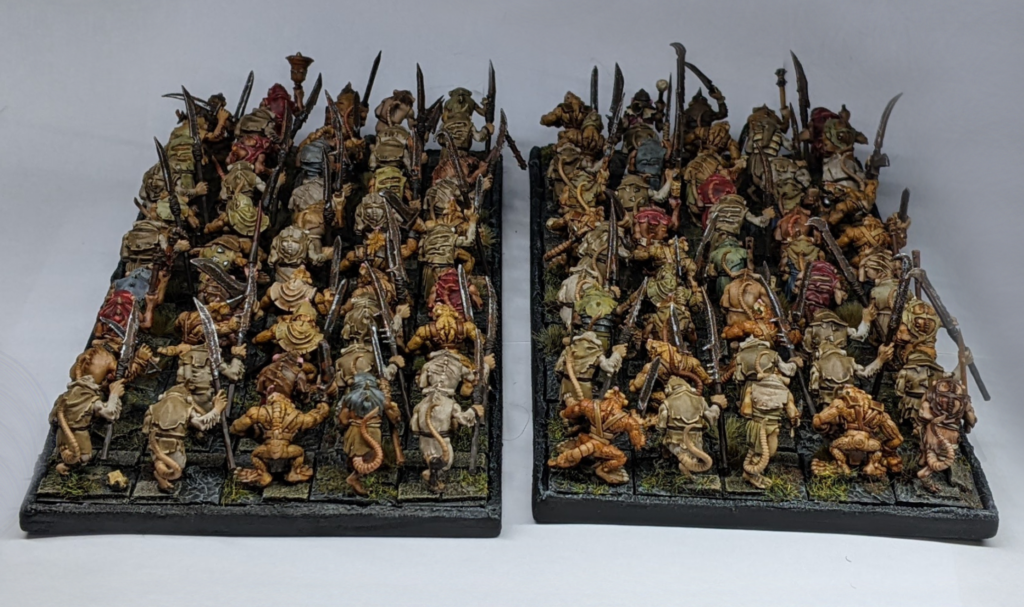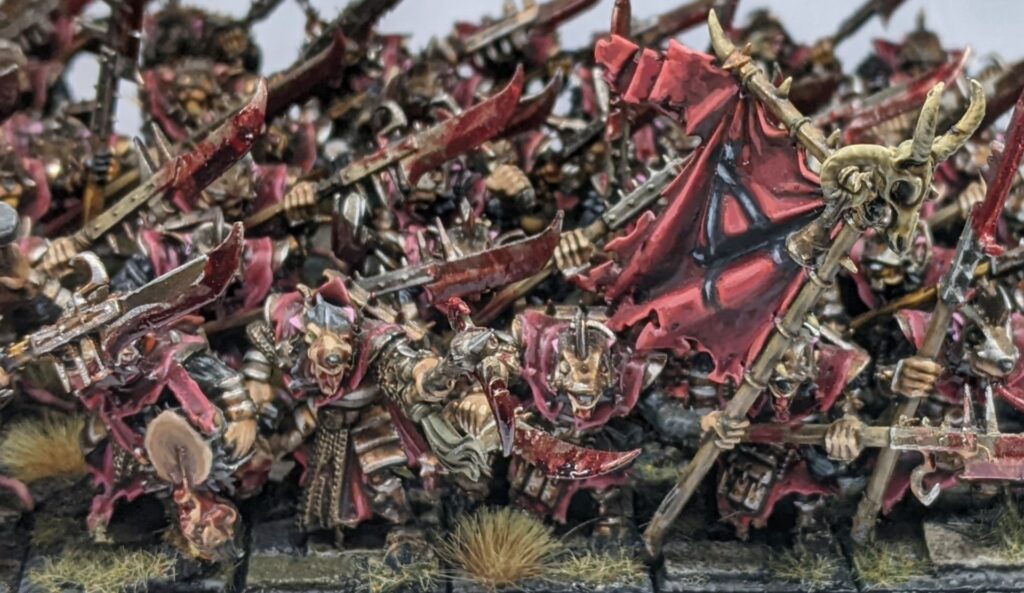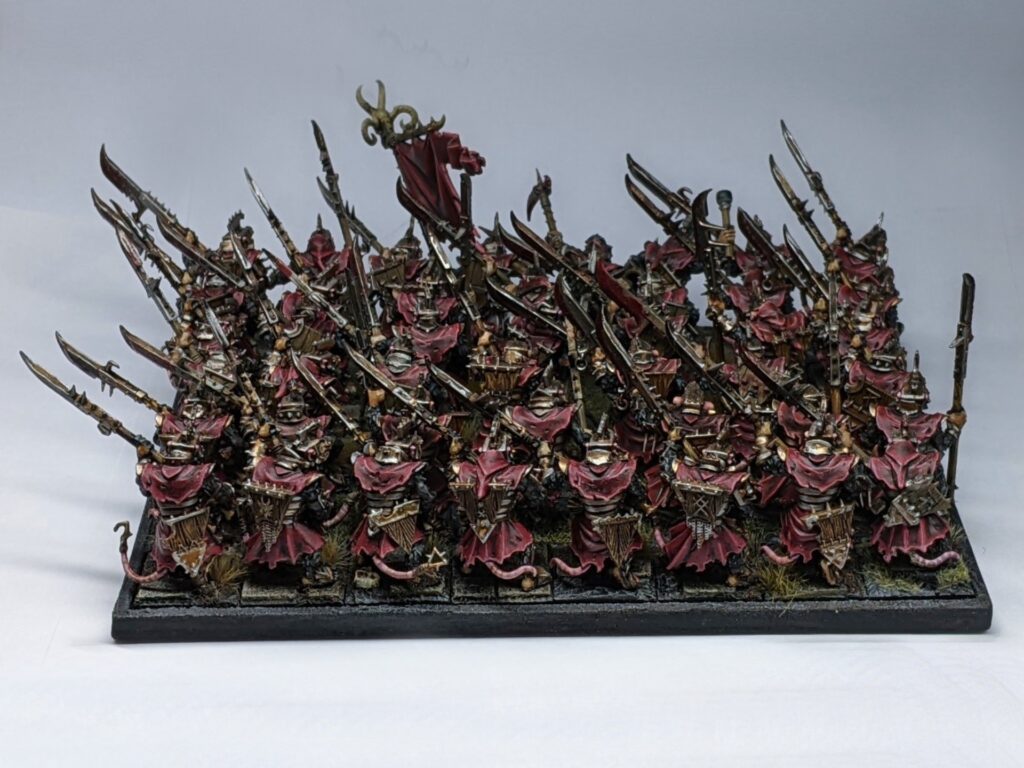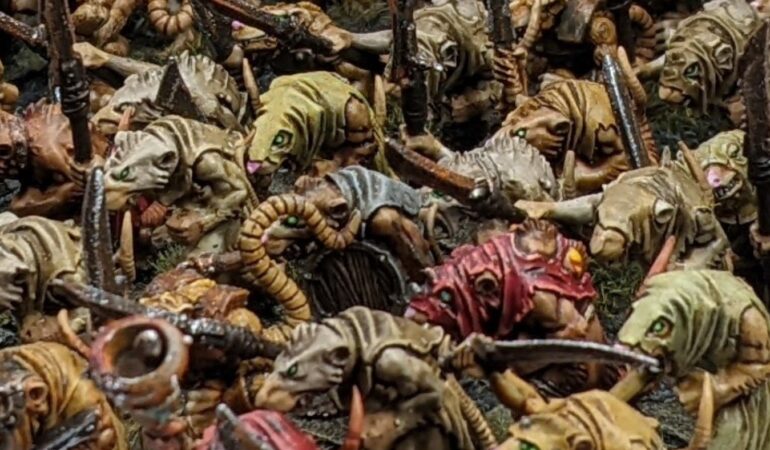
We sure are getting through this series. I might still be overcompensating for my hobby dry spell at the end of 2021, but I can’t deny that it’s been extremely motivating to see this army come together so quickly. I started on this journey intending clear a couple models off my backlog before the new year, and here we are two months in with no end in sight.
In this update1, I’m going to be taking a hard look at the core of my Skaven army – the troops of Clan Verminus. With many of the monsters, toys and tools from 7th Edition now in my collection, it’s becoming a bit of a stretch to call this a 6th Edition Skaven army – and that means the rest of the army needs to get with the times. Thanks to the boost given to my Clanrats in Part Two of Vermintide, the backbone of my army is looking pretty solid. Three blocks of 40 Clanrats is a decent start to any 8th edition Skaven army, but there’s an elephant in the room that I’ve been trying really hard to ignore for some time now – Skaven Slaves.
Skaven Slaves are probably the single most talked about unit in the Skaven army, and for good reason – they’re only two points a model! Granted, they don’t have armour, they’re WS2 and they’ve got what I believe to be the lowest base Leadership value in the game, but what do you expect for a measly two points, eh? Throw in the ‘Life is Cheap’ rule that prevents them from causing panic checks to the rest of your army and you’ve got one of the best tarpit units in the entire game. Throw them into your opponents scariest unit and watch them waste turn after turn hacking away at 50 model unit that only cost you 100 points. Better yet, laugh maniacally as you shoot everything you have into the combat. You killed six Slaves and a single Ironbreaker? Well, point for point you’re still coming out better from that exchange. If they actually manage to kill something in combat, well, that’s just gravy. They have neither the armour save nor the autonomy of the somewhat more reliable Clanrats, but keep them in your Generals leadership bubble and everything will be fine.
Slaves represent one of the central tenets of what a Skaven army is really about – throwing enough lives at a problem until it’s not a problem any more. They’re instrumental to reaching the eye-watering model counts that Skaven are known for – so much so that the concept has been duplicated across just about every system that features a Not Skaven™ army. Mantic’s Kings of War features Wretches in Hordes or Legions of 40 to 60 models, while the Vermin Swarm list for The Ninth Age features Vermin Slaves in units of 30 up to a staggering 80 models.
Okay, so they’re ubiquitous, useful, fluffy, fun to use and impressive to behold in their numbers. That all sounds great, so why have I been trying so hard to pretend they don’t exist until this point?
Well, because then I’d have to paint them! The prospect of painting another 100+ Clanrat models is incredibly daunting, especially when you’re still just trying to get your army off of the ground. It’s not like these are simple miniatures like Bloodletters or Space Marines – Clanrats are surprisingly involved models to paint. There’s fur, skin, claws, eyes, noses, garments, weapons, tails, pustules and even little accessories like straps, belts and pouches. These aren’t the sort of models you can give a quick zenithal undercoat and an ink wash – there’s a lot of detail to pick out on these. 100 of these will net you all of 200 points in a game of Warhammer – some armies don’t bring that many models in a 2000 point game.
Better yet, one does not simply go out and buy a box of Clanrat Slaves. If you pick up a box of Skaven Clanrats – not the models from Island of Blood2 – you’ll receive 10 Clanrats with armour and helmets and a further 10 that look altogether more disheveled. These models have no armour to speak of – no upper body clothing at all in some cases – manacles around their legs, whip scars, all that good stuff. The idea here is that if you just want to use them all as Clanrats, you can, but you can also use these to represent Skaven Slaves with more than just a shabbier looking paint job. This is all well and good, unless you already happen to own about 120 of Clanrats, most of which are monopose models from Island of Blood. That’ll teach me to buy models second hand, eh?
So, what’s the solution here? Buy about 10 boxes of Skaven Clanrats and throw half of the models in my bitz box? Nah, forget that – the second hand market got me into this mess, and it’s now going to get me out of it too!
For some time now, I’ve been keeping an eye on eBay, Facebook and the fickle machinations of fellow wargamers in my local area for any Skaven Clanrat models going second hand. The trick here is that you need to be picky, but not stingy. If you can find a lot of 20 used Skaven Slave models going for about the same rate as a NIB box of Clanrats at full RRP, believe it or not you’re actually wining. Sure, they might be used, they’re probably not painted to a Golden Demon standard and probably not in your own armies colour scheme – but you’re getting twice the number of Slave models than you would from a sealed box. Better yet, if the miniature is already assembled and painted, then you can save yourself a lot of time and effort performing dull, menial work like cutting models off of the sprue, shaving down the mould lines and applying the base coats. Time is money after all, and every second we save doing tedious easy tasks is another second we can spend making our minis look good – it all adds up over 100+ minis. This is where ‘being picky’ becomes essential. Too cheap and nasty will end up increasing your workload; you may have to shave mould lines off (and repair the paint you’ve sliced off), fix wonky arms, fill gaps and strip overthick paint. On the other end of the spectrum, too nice a paintjob and you’ll end up paying way more than retail prices. Worse yet, you’ll wind up with something that’s pretty much finished as is, and that kind of defeats the purpose of the hobby altogether. There’s a sweet spot to be found, where the old paint job saves you hours of tedious boring base coats, but leaves enough you space to make it your own. The old paint job doesn’t have to be especially neat and tidy, just so long as it’s not on too thick. In most cases, you can simply throw an Agrax Earthshade wash over the whole miniature and you’re ready to start layering and highlighting. Any inconsistencies that remain after the wash will disappear in the layering and highlighting, and you’ll have saved about 5 minutes of base coating per mini; that’s over 8 hours of labour saved over 100 models.
I managed to source my 100 Clanrat Slaves from about 4 or 5 different sources. Some from eBay, some from friends, some were old half finished models from my bitz box. There were also a decent amount of obvious Slave models lurking in my Clanrats with Hand Weapons unit, which I dutifully pilfered for the Slaves and replaced with a freshly painted Clanrat (of which I have plenty of spares now). This mishmash of Slave models produced 2 units of 50 with a wide variety of different sculpts, poses, colours and weapons. The vast majority of these are Clanrat Slave models with a hand weapon of sorts and no shield, but – despite what I said earlier about being picky – sometimes beggars can’t be choosers, and there’s more than a few spears thrown in the mix as well. There’s maybe 10 or so lucky little rats that found themselves a nice shield3 and even around 20 of the old school plastic monkey-looking Clanrat models from 6th edition in the mix (many with shortened or in some cases completely docked tails, the poor little wretches).
If that sounds messy, well, it’s because it is – but that’s okay. Clanrat Slaves are chaff, consisting of the remnants of rival clans or simply unfortunate souls born into servitude. This being the case, it figures that there would be Skaven of all different furs, builds and subspecies in there, garbed in the tattered uniform of their former clan or whatever they could scrounge off a corpse to keep themselves warm. Likewise, it figures that the unit wouldn’t be armed especially coherently either – there’s already such a wide variety of hand weapons in the Clanrats kit that the odd spear and/or shield in the unit isn’t going to look too out of place. As far as honouring WYSIWYG goes, my gut tells me that majority rules and – at a glance – the unit reads as ‘hand weapon, no shield’, which is just fine by me.
So, what exactly did I do to these models and how can I get away with calling this my paint job if I bought them all used and painted? Well, quite a lot, actually. The first thing was to get 100 bases painted and ready, then snip the models off their old square or round bases and get them ranking up nicely once again. The next step was to pick out all the models that looked like they maybe didn’t have enough shading in the recesses and applied a 50:50 mix of Agrax Earthshade and Seraphim Sepia everywhere that it was needed. This was an all over wash for the old school Clanrats, while a lot of the newer models benefitted more from pin washes in the folds of their ragged robes to give them a little more contrast. Once the wash had dried4, I sorted all of the models by the colour of their robes (red, blue, green, neutral) and went about picking out the most extreme highlights on their robes – edges, creases, that sort of thing. The vast majority of these were done with Vallejo Game Color Khaki, with a little Heavy Red, Camo Green or Heavy Blue mixed in whether I was highlighting red, green, blue or whatever as and when I needed it. With this many models bunched up in a regiment, the lower half the model is considerably less important, so I focussed most of my time and energy on highlighting hoods, collars and sleeves.
With the robes highlighted, I then went about making sure the skin popped – faces and hands, especially, as these were the focal points of the model from the front. My technique here was simple – layer on Heavy Skintone, add a finer layer with 50:50 Elfic Flesh then add a final highlight with Elfic Flesh. Repeat for all of the rats whose faces didn’t look up to snuff, and then come in and throw a light wash of Seraphim Sepia over the highlighted skin. Quick, easy and very effective.
Next, it was time to work on some unifying features that would help pull the whole unit together. I painted a bunch of their noses in Squid Pink, highlighted with a tiny dot of Squid Pink/Elfic Flesh. I went and dotted all of the eyes with a bit of white paint, then came back in with two coats Biel Tan Green wash. This was actually very effective and gives a nice eerie green glow in hardly any time at all. The final unifying feature was the weapons – I wanted these to look especially gnarly and rusty, so I gave every blade or bludgeon a quick coat in Typhus Corrosion, followed by a drybrush of Ryza Rust and an edge highlight of Shining Silver. Another quick and easy step that ties the whole unit together and makes all of their weapons look like rusty junk.
That was about it really. I’m actually really, really chuffed with how these Skaven Slaves turned out. The sheer variety of poses, weapons, colours, and even models in this squad makes them a lot of fun to pour over up close, but they still look striking from a distance as well. Absolutely no-one is going to mistake this lot for my regimented, uniformed Clanrats either.
The addition of these two units of Slaves really feels like a turning point for the project. I’ve never owned an army with 220 models just in the core troops, and I’m thrilled to be able to do so now without having to compromise too much on the quality of the paint jobs either. Skaven Slaves are such a huge part of the Skaven army and they way they make war in every edition of the game, so I feel more invigorated than ever to get this vermin horde on the tabletop and play some games.
If Skaven Slaves are the lowest of the low in the Verminus Clans, then Stormvermin are the crem de la crem. I’m a big fan of these guys aesthetically and – having had 20 of the old metal minis in my first WHFB army back in the day – I’ve got a lot of nostalgia for them too. That being the case, there’s absolutely no way I’m going to let them languish at a paltry 30 models now that this army is coming over to 8th and beyond.
These guys painted up very quickly, all things considered. As with my Slaves, I managed to secure a great big pile of the models second hand, which were pretty well assembled for the most part. Like the Slaves again, they also came pre-painted. Given that these had to match up with the rest of my existing Stormvermin, however, I had to be a little more fussy with the repainting. Even after repainting the cloth, the ears and the tail, I still managed to save a ton of time basecoating the shields, and metallics. After a quick all over wash of Agrax Earthshade, I just followed my same process I’d done previously for highlighting the cloth, layering the armour in Bright Bronze and highlighting with Chainmail Silver. I applied a subtle grey stippling over the fur before knocking it back with Nuln Oil. After painting the faces and hands in the same fashion as the Slaves, they were pretty much good to go.
While I was working on these additional Stormvermin, it occurred to me that the banner standard in the unit was looking a little bit plain. There’s a very simple reason for this – these are old miniatures as far as my personal collection goes. I painted this banner as part of one of my first armies for Age of Sigmar, and didn’t feel especially up to the task of freehand painting iconography. Times have changed however, and I have a little more experience painting iconography both simple and somewhat more ambitious. It seemed a little unjust that my Plague Monks should get have an icon on their banner while the Stormvermin carried a flap of red cloth, so I did my best to replicate the symbol of the horned rat here as well. This was a little more challenging than it was on the Plague Monks’ nice flat surface, but I’m happy with the outcome.
The one regret I do have with these Stormvermin is that I wasn’t able to completely replicate how I’d painted the shafts of their halberds. This was a unit whose first 20 or so I’d painted a good 5 years ago at this point, so I’m not beating myself up too much about it, but it is mildly annoying. Ah well, just about a 50:50 split between the new and the old at this point anyway.
After a somewhat delayed basing process5, the unit was complete. I was absolutely chuffed to bits with this big unit of elite Stormvermin – just look at them, they look brilliant in a big block, all tightly ranked up. You may have noticed that I’m photographing these units on movement trays now (magnetic MDF trays from Frontier Wargaming). It’s gets a little.. uhh.. unwieldy trying to move 50 loose miniatures around to take photographs of them. It’s a nice problem to have.
Onto my final miniature of this update – the named character. I thought long and hard about doing Queek Headtaker for Clan Verminus – I do love the mini and the character and it would suit the theme well. That said, I feel like I have even less use for Queek in a game right now than I do any of the other named characters. I’ve already got a Warlord miniature – my Games Day Warlord – which I absolutely love. Besides that, I’ve already painted a Queek already (sort of) – so let’s take advantage of the fact there’s not going to be an Eshin chapter of Vermintide6 any time soon and shoehorn in Deathmaster Snikch.
I wasn’t entirely convinced that I liked the model for Deathmaster Snikch at first. His cloak seemed a little ostentatious for my liking. I see what the sculpt is going for – trying to emulate the triangular horned rat symbology – but his tail scimitar is doing this already. Part of me wanted to chop the tail of his cloak off and smooth out the corner with an x-acto knife, but.. I dunno, this felt disrespectful to the intent of the model or something.
As far as painting goes, the main difference in my approach to this character over my Gutter Runners was the choice to add a little turquoise into my grey highlights over the black cloak. This is an something that’s super common on a lot of Games Workshop’s box art – presumably because a little colour in your highlights makes for a richer, more visually interesting paint job than sticking aggressively to greyscale. It’s not something I use often on my own models however, as I find it can look a little cartoonish. That said, I wanted Deathmaster Snikch stand out from his nameless inferiors as a unique character, so I gave it a shot. I’m really happy that I did, because I’m really pleased with how it turned out – particularly the glazing on the softer folds of the cloak and the specular highlights. I do think that it makes his cloak look a little more midnight blue than it does black, but I probably went a bit overboard with the colour given that it was my first attempt. Still, you live and learn. It was fun to get out of my comfort zone a little on this one.
And that about wraps it up for Part Five of Vermintide. Not the widest selection of models I’ve ever done in one of these updates, but by some way the largest model count since Part One. The addition of these Skaven Slaves and Stormvermin take my total body count in the army from roughly 310 up to a whopping 430 models, which is a pretty wild figure for an army I haven’t actually played a game with yet7.
Still, there’s always more miniatures to add – and one more Greater Clan left to reinforce! Check back here soon for Part Six of my journey deeper into Skavenblight as we fill out everybody’s favourite smelly rodents, Clan Pestilens.
Until then, thanks for reading and happy wargaming!
1 I’m going to stop referring to these updates as ‘months’ at this point, as the series is coming out a lot faster than my usual one-a-month updates.
2 Whose models incidentally account for the vast majority of my Clanrats.
3 Far more before I very carefully prized away any of the optional shields from the non-Island of Blood models.
4 One benefit of batch painting 100 models at a time is that you very rarely need to wait for anything – by the time you’re finished model number 100, the first is ready for more work.
5 I’d actually managed to finish them before my next big order of bases had arrived – talk about a nice problem to have.
6 Clan Eshin really have gotten no love over the years. It’s a good job than it’s Clan Eshin representing in Mordheim, because otherwise I’d have barely any interaction with them. Look, Gutter Runners are great but I already expanded those up to 12 in Part 2, I’ve already got a regular Assassin and Triads haven’t been a thing since 5th Edition WHFB. Granted, Night Runners are conspicuously absent from my army at this point, but let’s be real here – they look like ass and they don’t do anything especially interesting in game.
7 Okay, this isn’t strictly true. I’ve yet to play a game with this army since I rebased it and started expanding – but I did play a few games with the core of this army back when it was an Age of Sigmar project and even took them to a couple of events.
